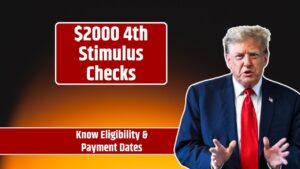Nearly one million Americans are set to receive stimulus payments of up to $1,400, thanks to a new initiative by the Internal Revenue Service (IRS). These payments are being issued to individuals who were eligible for the Recovery Rebate Credit (RRC) but failed to claim it on their 2021 tax returns. With nearly $2.4 billion on the table, the IRS is stepping in to ensure no eligible taxpayer misses out.
Let’s break down who qualifies, how much they can receive, and what steps—if any—you need to take to get this unexpected financial boost.
What Is the Recovery Rebate Credit?
The Recovery Rebate Credit is a tax credit designed to help people receive any stimulus payments (also called Economic Impact Payments) they missed during the pandemic. It was particularly relevant for the third round of stimulus checks in 2021, which provided up to $1,400 per person under the American Rescue Plan Act.
Taxpayers could claim the RRC when filing their 2021 returns if:
- They didn’t receive a stimulus check.
- They received less than the full amount they were eligible for.
- Their circumstances changed in 2021 (like income or dependents) that made them newly eligible.
Unfortunately, many people either left the RRC section blank or entered $0 by mistake—meaning they missed out on money they were legally entitled to.
Who Is Eligible for These New Payments?
To qualify for this round of payments, taxpayers must meet all three of the following criteria:
Filed a 2021 Tax Return
You must have submitted your 2021 tax return, which the IRS uses to determine eligibility.
Didn’t Claim the Recovery Rebate Credit
Your return either:
- Left the RRC section blank, or
- Reported $0 for the credit, even though you qualified.
Eligible for Economic Impact Payments
You must have been eligible for at least one of the three federal stimulus checks issued in 2020 and 2021.
Here’s a quick reference:
| Requirement | Explanation |
|---|---|
| Filed 2021 tax return | Must be submitted to qualify |
| Missed RRC on return | Either left blank or entered $0 |
| Eligible for stimulus | Based on income, dependents, and other criteria |
How Much Will You Receive?
The maximum amount is $1,400 per individual, but the actual payment will depend on:
- Your income in 2021.
- Your filing status (single, head of household, married filing jointly).
- The number of dependents you claimed.
Example Scenarios:
| Scenario | Total Payment |
|---|---|
| Single person, missed entire Round 3 | $1,400 |
| Married couple with two kids | $5,600 |
| Single parent with one child | $2,800 |
The IRS will calculate what you’re owed based on your 2021 return and subtract any stimulus you already received.
How Will the IRS Send the Money?
The process is automatic—you don’t need to apply or refile. The IRS is using its existing systems to distribute the funds efficiently.
Delivery Methods:
- Direct Deposit: Sent to the bank account used on your latest return (likely your 2023 filing).
- Paper Check: Mailed to the address the IRS has on file if no bank info is available.
What You’ll Receive:
- A notification letter from the IRS explaining your payment amount and how it was calculated. Keep this for your records.
Expected Timeline:
- Payments will begin arriving in late January 2025.
Check your bank or mailbox and report delays if nothing arrives by February.
Haven’t Filed Your 2021 Return Yet? You Still Have Time
The IRS is also giving people who never filed a 2021 tax return a final chance to claim their money. The deadline is April 15, 2025.
This includes people with:
- Low or no income in 2021.
- Non-traditional income (gig work, small business, etc.).
- No filing requirement but potential eligibility for the RRC.
If you think you may qualify, it’s strongly recommended to file your 2021 return now. Doing so could unlock a payment of up to $1,400 per person in your household.
Overview of Past Stimulus Payments
To understand why this matters, here’s a breakdown of the three stimulus rounds:
| Stimulus Round | Individual Amount | Per Dependent | Legislation |
|---|---|---|---|
| Round 1 (Mar 2020) | $1,200 | $500 | CARES Act |
| Round 2 (Dec 2020) | $600 | $600 | Consolidated Appropriations Act |
| Round 3 (Mar 2021) | $1,400 | $1,400 | American Rescue Plan Act |
Combined, these payments totaled $814 billion, and the IRS is now working to make sure no eligible American is left behind.
Why Now?
IRS Commissioner Danny Werfel said the agency discovered nearly one million taxpayers failed to claim the credit due to confusion or filing mistakes. Instead of requiring extra paperwork, the IRS is fixing the issue themselves and sending the money out automatically.
This effort is part of a broader IRS mission to improve customer service, simplify processes, and ensure taxpayers get what they’re owed.
If you’re among the many Americans who struggled during the pandemic and might have missed a credit, now’s the time to double-check your records or get your 2021 return filed. With payments arriving soon, you could be receiving a much-needed financial boost without lifting a finger.
FAQs:
Do I need to refile my taxes to get this payment?
No, if you already filed your 2021 return, the IRS will handle everything automatically.
What if I never filed a 2021 tax return?
You must file it before April 15, 2025, to qualify for the Recovery Rebate Credit.
Will this payment affect my taxes for 2025?
No, the payment is a refundable tax credit and does not count as taxable income.




















